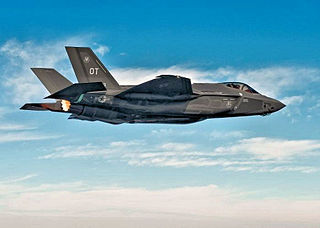
Nellis Air Force Base is a United States Air Force installation in southern Nevada. Nellis hosts air combat exercises such as Exercise Red Flag and close air support exercises such as Green Flag-West flown in "Military Operations Area (MOA) airspace", associated with the nearby Nevada Test and Training Range (NTTR). The base also has the Combined Air and Space Operations Center-Nellis.

Tactical Air Command (TAC) is an inactive United States Air Force organization. It was a Major Command of the United States Air Force, established on 21 March 1946 and headquartered at Langley Air Force Base, Virginia. It was inactivated on 1 June 1992 and its personnel and equipment absorbed by Air Combat Command (ACC).

The Air Education and Training Command (AETC) is one of the nine Major Commands (MAJCOM) of the United States Air Force (USAF), reporting to Headquarters, United States Air Force. It was established 1 July 1993, with the realignment of Air Training Command and Air University.

Luke Air Force Base is a United States Air Force base in Maricopa County, Arizona, United States. It is located 7 miles west of the central business district of Glendale, and 15 miles west of Phoenix.

Tonopah Test Range Airport, at the Tonopah Test Range is 27 NM southeast of Tonopah, Nevada, and 140 mi (230 km) northwest of Las Vegas, Nevada. It is a major airfield with a 12,000 ft × 150 ft runway, instrument approach facilities, and nighttime illumination. The facility has over fifty hangars and an extensive support infrastructure.

The 64th Aggressor Squadron is a United States Air Force unit. It is assigned to the 57th Adversary Tactics Group at Nellis Air Force Base, Nevada.

The 65th Aggressor Squadron is a United States Air Force unit currently operating the F-35A Lightning II. It is assigned to the 57th Operations Group at Nellis Air Force Base, Nevada.

The 414th Combat Training Squadron is a United States Air Force unit assigned to the 57th Wing, 57th Operations Group at Nellis Air Force Base, Nevada. The 414th is a non-flying organization charged with hosting Red Flag exercises, Air Combat Command's largest Large Force Exercise (LFE).

The 57th Wing is an operational unit of the United States Air Force (USAF) Warfare Center, stationed at Nellis Air Force Base, Nevada.

The 178th Wing is a unit of the Ohio Air National Guard, stationed at the Springfield-Beckley Municipal Airport ANG complex, Springfield, Ohio. If activated to federal service, the wing is gained by the United States Air Force (USAF) Air Combat Command (ACC), with elements of the wing gained by the Air Force Intelligence, Surveillance and Reconnaissance Agency (AFISRA).

The 162nd Attack Squadron is a unit of the Ohio Air National Guard 178th Wing located at Springfield Air National Guard Base, Springfield, Ohio. The 162nd is equipped with the General Atomics MQ-9 Reaper UAV.

The United States Air Force Warfare Center (USAFWC) at Nellis Air Force Base, Nevada, reports directly to Air Combat Command. The center was founded on 1 September 1966, as the U.S. Air Force Tactical Fighter Weapons Center. It was renamed the U.S. Air Force Warfare Center in 2005.

The 422d Test and Evaluation Squadron is a United States Air Force unit. It is assigned to the 53d Test and Evaluation Group, stationed at Nellis Air Force Base, Nevada. The squadron performs operational testing of all fighter aircraft and munitions entering and in operational use by Air Combat Command.

The 4450th Tactical Group is an inactive United States Air Force unit. It was headquartered at Nellis Air Force Base, Nevada, and operationally located at Tonopah Test Range Airport, Nevada. It was inactivated on 5 October 1989.

The 433rd Weapons Squadron is a United States Air Force unit, assigned to the USAF Weapons School at Nellis AFB, Nevada.

The 57th Operations Group is the operational component of the 57th Wing, assigned to the United States Air Force's Air Combat Command. The group is stationed at Nellis Air Force Base, Nevada.

The 14th Weapons Squadron is a United States Air Force unit. It is assigned to the USAF Weapons School, stationed at Hurlburt Field, Florida.

The United States Air Force's 66th Weapons Squadron is a United States Air Force Weapons School Fairchild Republic A-10 Thunderbolt II instructional flying unit, at Nellis Air Force Base, Nevada.

Jeannie Marie Leavitt is a retired United States Air Force (USAF) general officer. She became the U.S. Air Force's first female fighter pilot in 1993, and was the first woman to command a USAF combat fighter wing. In April 2021, she was appointed to replace Major General John T. Rauch as Chief of Safety of the United States Air Force, and assumed office on August 13, 2021.


























